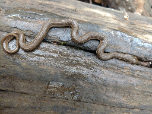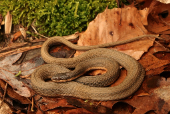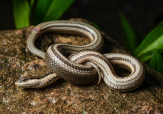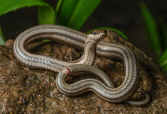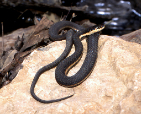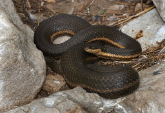Queen Snake (Regina septemvittata)
Description: The queen snake is similar in appearance to a garter snake, genus Thamnophis, so is often confused with that group. The queen snake is olive to gray or dark brown in overall coloration, with peach or yellow stripes that run down its length at the first scale row. There are also four prominent ventral stripes of a darker color, and as no other similar species has stripes running down the length of its belly, this is an important feature in identifying this snake. In the young and juvenile snakes there are three extra stripes: one stripe that runs along the vertebral dorsal scales, and two stripes (one on each side) that run down the length of the body at scale rows five and six. These extra stripes tend to fade as the snake matures, but when young the snake will have a total of seven stripes, three on the back and four on the belly, which gives cause for its taxonomical reference name, Regina (queen) septemvittata (seven-striped). The belly of the snake is a cream to yellow color.
The head of the queen snake is narrow and has nine large plate-like scales on the top, and the chin has several rows of thicker scales. This is a protective adaptation, for the snake's feeding habit of chasing its prey under rocks. The pupil of the eye is round, a feature shared with most other colubrids. There are 19 rows of keeled dorsal scales at midbody, and the anal plate is divided. The sexes are often difficult to distinguish based on external characteristics. Male queen snakes have relatively longer tails than females. Males have from 65 to 89 subcaudal scutes (average 76), with the tail from 23% to 34% of the snake's total length. Females have 54 to 87 subcaudals (average 69), with tails equal to 19% to 27% of total length.
Queen snakes are not large, and they seldom grow to more than 24 inches in total length (including tail). The females are generally slightly larger than the males.
Habitat: The habitat requirements for the queen snake are very specific, and this snake is never found in areas that lack clean running streams and watersheds with stony and rocky bottoms. The water temperature must be a minimum of 50 °F during the snake's active months. This is in a large part due to the snake's dietary requirements. They subsist almost entirely on fresh water crayfish. It preys almost exclusively on newly-molted crayfish, which are not able to defend themselves effectively with their pincers. One study indicates that crayfish make up over 90% of the snake's diet. Other sources of food include frogs, tadpoles, newts, minnows, snails, and fairy shrimp. The queen snake does not find its food by sight or heat detection, but by smell, using its tongue to carry the scent of its prey to receptors within its mouth. In this way it is able to home in on its prey, even under water.
Range: R. septemvittata ranges through the temperate region of North America east of the Mississippi River from western New York state to Wisconsin and south to Alabama and northern Florida. It is also found in the southwestern parts of Ontario.
Diet: een snakes are described as dietary specialists, feeding primarily on crayfish. They have been documented favoring crayfish that are freshly molted. R. septemvittata are especially sensitive to a chemical compound called ecdysone that is produced by crayfish during their molting cycle which help them find that prey easier. One study done offered crayfish during their molting cycle and crayfish not on their molting cycle to queen snakes to see which they preferred. The results showed that the queen snakes would not eat the prey if it was not releasing ecdysone. If none of these prey can be found, queen snakes will resort to eating small fish.
Reproduction: Female queen snakes will be fully sexually mature at three years of age, males at two years. Breeding takes place in the spring and autumn months. If mating was in the autumn, the female can delay giving birth until spring, storing the energy she will need through the months that she will be in a period of brumation. This snake is ovoviviparous, the female giving birth to live young after carrying the eggs within her body. This differs from oviparous and viviparous snakes. Litter size can vary from 5 to 20, and the time for an individual birth is from 1.5 to 2.5 minutes. Time between individual births is 4 minutes to 1 hour, with the average time being 11 minutes.
The newly born snakes will be approximately 6 inches long and weigh 0.1 ounces. Newborn snakes begin to grow very rapidly and may shed their skin twice in their first week while living on the nutrient rich yolk stores they preserve through this time in their lives. The baby snakes are able to swim and move about and they must fend for themselves independently directly after birth. Juvenile queen snakes range from 6.9 to 9.1 inches in length.
Status: Listed as Least Concern in view of its wide distribution, presumed large population, and because it is unlikely to be declining fast enough to qualify for listing in a more threatened category.
»» Kingdom: Animalia - Animals
»» Phylum: Chordata - Chordates
»» Subphylum: Vertebrata - Vertebrates
»» Class: Reptilia - Reptiles
»» Order: Squamata - Scaled Reptiles
»» Suborder: Serpentes
»» Superfamily: Colubroidea
»» Family: Colubridae - Colubrids
»» Genus: Regina
»» Species: Regina septemvittata - Queen Snake
This article uses material from the Wikipedia article "Queen Snake", which is released under the Creative Commons Attribution-Share-Alike License 3.0. Content may have been omitted from the original, but no content has been changed or extended.
|


